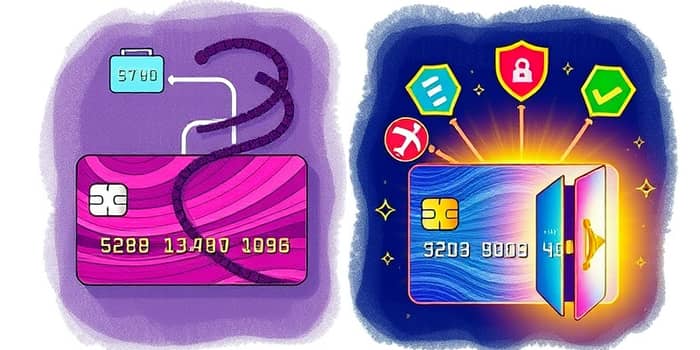In today’s dynamic financial landscape, understanding the nuances between debit and credit cards is essential for anyone aiming to make informed financial decisions. Though these cards appear nearly identical—with reliable EMV chips, a magnetic stripe, and a familiar layout—they serve distinct functions and unlock unique benefits. By exploring their differences, users can harness the right tool to manage daily expenses, build credit, or pursue rewarding perks.
Understanding the Basics
At first glance, both debit and credit cards share common physical features: a 16-digit card number, expiration date, and security codes. Each can facilitate purchases online or at merchants, and both allow ATM withdrawals. However, the core distinction lies in where the funds originate and how the transaction is settled.
Debit cards draw money immediately from an existing bank account. Whenever a purchase is made, funds are deducted in real time, guaranteeing that spending is constrained by available balances. Conversely, credit cards provide access to a pre-approved line of credit, essentially lending you money up to a predetermined limit. You can make purchases now and repay the balance later, often within a grace period before interest accrues.
Source of Funds and Spending Limits
Choosing between debit and credit often hinges on spending habits and risk tolerance. With debit, users benefit from simplicity and direct control; each transaction reduces the account balance, offering clear visibility into one’s financial position. Yet overspending may trigger overdraft fees if the bank honors transactions without sufficient funds.
Credit cards, by contrast, expand purchasing power. Your credit limit defines the maximum you can borrow, but mismanagement can lead to high interest costs and escalating debt. When used wisely, credit cards grant flexibility and the ability to handle unexpected expenses without immediate cash on hand.
Fees, Interest, and Consumer Protections
Fee structures and security measures vary significantly between the two card types. Because debit cards use personal funds, interest is not charged. However, overdraft penalties may apply if transactions surpass the available balance. Meanwhile, credit cards often come with annual fees, though many issuers waive them or offer fee-free options. Interest rates on unpaid balances can be steep, underscoring the importance of paying in full each month.
When it comes to fraud protection, credit cards generally provide stronger safeguards. Most issuers implement zero liability policies, meaning cardholders are not held responsible for unauthorized charges if reported promptly. Debit cards have improved their security features, including real-time alerts, but recovering funds can take longer, potentially disrupting cash flow.
Building Credit vs Maintaining Budget
One of the most compelling reasons to use credit cards responsibly is the impact on credit scores. Regular on-time payments and low credit utilization contribute to a build a positive credit history, which opens doors to favorable loan rates and financial opportunities. Debit cards, conversely, have no effect on credit profiles, making them less useful for credit building initiatives.
Debit cards excel for those focused on fiscal discipline. By linking spending directly to actual balances, users can cultivate prudent habits and avoid accumulating debt. This makes debit an attractive option for budgeting, as it inherently prevents expenditures beyond available resources.
Practical Decision-Making Tips
Selecting the right card often depends on personal goals and lifestyle. Consider these strategies to align your choice with your objectives:
- Assess your spending habits: if you prioritize rigid control, debit may be ideal.
- Aim to pay statements in full: use credit cards to accumulate rewards without interest.
- Monitor real-time alerts and transactions to detect fraud early.
- Leverage credit responsibly to avoid unnecessary interest charges and boost credit scores.
- Choose cards with perks that match your needs—cash back, travel rewards, or purchase protection.
Demographics and Usage Trends
Understanding who uses which card can offer further perspective. In 2025, 85% of consumers carry a debit card, completing an average of 35 transactions per month and spending around $1,600. Fraud rates on debit cards have declined by 18% over five years, thanks to stronger chip technology and monitoring systems.
Generational preferences also reveal distinct patterns:
- Gen Z (18–25 years): 60% prefer debit for disciplined spending.
- Millennials (26–41 years): 55% leverage credit to maximize rewards.
- Gen X (42–57 years): 68% favor credit cards for travel perks.
- Baby Boomers (58+ years): 72% use credit cards, often due to established credit lines and familiarity.
Embracing Your Financial Journey
Choosing between debit and credit cards is more than a technical decision; it reflects personal values, financial maturity, and long-term goals. Whether you seek the immediate security of a debit card or the potential to build credit and earn rewards with a credit card, both tools can serve you effectively when used thoughtfully.
Ultimately, the key lies in harnessing each card’s strengths. Use debit cards to maintain cash flow and prevent overspending. Employ credit cards to cultivate creditworthiness, unlock exclusive benefits, and handle emergencies with grace. By adopting a conscious approach, individuals can effective budgeting and spending control while laying the foundation for a healthier financial future.
Whichever path you choose, remember that knowledge and self-awareness empower your decisions. Stay informed about card terms, set clear budgets, and review statements regularly. With these practices in place, your debit and credit cards become not just plastic instruments, but catalysts for confidence, resilience, and growth. Embrace your financial journey with clarity, purpose, and the tools that best align with your goals.
References
- https://www.investopedia.com/articles/personal-finance/050214/credit-vs-debit-cards-which-better.asp
- https://www.creditkarma.com/credit-cards/i/debit-vs-credit
- https://www.unfcu.org/financial-wellness/debit-vs-credit-cards/
- https://www.sccu.com/articles/personal-finance/debit-card-vs-credit-card-which-is-better
- https://www.pnc.com/insights/personal-finance/spend/debit-cards-vs-credit-cards.html
- https://www.clearlypayments.com/blog/debit-vs-credit-which-payment-method-do-consumers-prefer-in-2025/
- https://www.investopedia.com/ask/answers/050415/what-are-differences-between-debit-cards-and-credit-cards.asp
- https://www.santanderbank.com/personal/resources/credit-card/credit-card-vs-debit-card










